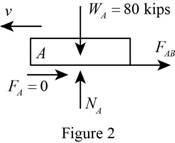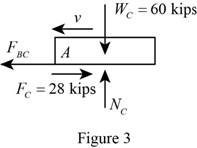
Concept explainers
(a)
Find the distance (x) required to bring the train to stop.
(a)
Answer to Problem 13.17P
The distance (x) required to bring the train to stop is
Explanation of Solution
Given information:
The initial speed of the train
The coefficient of kinetic friction
The weight of train A
The weight of train B
The weight of train C
Assume the acceleration due to gravity (g) is
Calculation:
Show the free body diagram of the train A, B and C with the forces as in Figure (1).

Convert the unit of initial velocity of trailer truck from
Calculate the force at A
Substitute 0.35 for
Calculate the force at B
Substitute 0.35 for
Calculate the force at C
Substitute 0.35 for
Calculate the total weight (W) using the relation:
Substitute
Calculate the mass of the truck (m) using the formula:
Substitute
Calculate the initial kinetic energy
Substitute
The final kinetic energy
Calculate work done
Substitute
Use work and energy principle which states that kinetic energy of the particle at a displaced point can be obtained by adding the initial kinetic energy and the work done on the particle during its displacement.
Find the distance (x) required to bring the train to stop:
Substitute
Therefore, the distance (x) required to bring the train to stop is
(b)
Find the force in each coupling.
(b)
Answer to Problem 13.17P
The force in coupling AB is
The force in coupling BC is
Explanation of Solution
Given information:
The initial speed of the train
The coefficient of kinetic friction
The weight of train A
The weight of train B
The weight of train C
Assume the acceleration due to gravity (g) is
Calculation:
Consider car A:
Show the free body diagram of the train A with the forces as in Figure (2).

Assume
Calculate the mass of the truck (m) using the formula:
Substitute
Calculate the initial kinetic energy
Substitute
The final kinetic energy
Calculate work done
Substitute
Use work and energy principle which states that kinetic energy of the particle at a displaced point can be obtained by adding the initial kinetic energy and the work done on the particle during its displacement.
The expression for the principle of work and energy is as follows;
Substitute
Consider car C:
Show the free body diagram of the train C with the forces as in Figure (3).

Calculate the mass of the truck (m) using the formula:
Substitute
Calculate the initial kinetic energy
Substitute
The final kinetic energy
Calculate work done
Substitute
Use work and energy principle which states that kinetic energy of the particle at a displaced point can be obtained by adding the initial kinetic energy and the work done on the particle during its displacement.
Find the force in coupling BC:
Substitute
Therefore, the forces in coupling AB and BC are
Want to see more full solutions like this?
Chapter 13 Solutions
Vector Mechanics for Engineers: Statics and Dynamics
- (read image) (answer given)arrow_forwardA cylinder and a disk are used as pulleys, as shown in the figure. Using the data given in the figure, if a body of mass m = 3 kg is released from rest after falling a height h 1.5 m, find: a) The velocity of the body. b) The angular velocity of the disk. c) The number of revolutions the cylinder has made. T₁ F Rd = 0.2 m md = 2 kg T T₂1 Rc = 0.4 m mc = 5 kg ☐ m = 3 kgarrow_forward(read image) (answer given)arrow_forward
- 11-5. Compute all the dimensional changes for the steel bar when subjected to the loads shown. The proportional limit of the steel is 230 MPa. 265 kN 100 mm 600 kN 25 mm thickness X Z 600 kN 450 mm E=207×103 MPa; μ= 0.25 265 kNarrow_forwardT₁ F Rd = 0.2 m md = 2 kg T₂ Tz1 Rc = 0.4 m mc = 5 kg m = 3 kgarrow_forward2. Find a basis of solutions by the Frobenius method. Try to identify the series as expansions of known functions. (x + 2)²y" + (x + 2)y' - y = 0 ; Hint: Let: z = x+2arrow_forward
- 1. Find a power series solution in powers of x. y" - y' + x²y = 0arrow_forward3. Find a basis of solutions by the Frobenius method. Try to identify the series as expansions of known functions. 8x2y" +10xy' + (x 1)y = 0 -arrow_forwardHello I was going over the solution for this probem and I'm a bit confused on the last part. Can you please explain to me 1^4 was used for the Co of the tubular cross section? Thank you!arrow_forward
- Blood (HD = 0.45 in large diameter tubes) is forced through hollow fiber tubes that are 20 µm in diameter.Equating the volumetric flowrate expressions from (1) assuming marginal zone theory and (2) using an apparentviscosity for the blood, estimate the marginal zone thickness at this diameter. The viscosity of plasma is 1.2 cParrow_forwardQ2: Find the shear load on bolt A for the connection shown in Figure 2. Dimensions are in mm Fig. 2 24 0-0 0-0 A 180kN (10 Markarrow_forwarddetermine the direction and magnitude of angular velocity ω3 of link CD in the four-bar linkage using the relative velocity graphical methodarrow_forward
 Elements Of ElectromagneticsMechanical EngineeringISBN:9780190698614Author:Sadiku, Matthew N. O.Publisher:Oxford University Press
Elements Of ElectromagneticsMechanical EngineeringISBN:9780190698614Author:Sadiku, Matthew N. O.Publisher:Oxford University Press Mechanics of Materials (10th Edition)Mechanical EngineeringISBN:9780134319650Author:Russell C. HibbelerPublisher:PEARSON
Mechanics of Materials (10th Edition)Mechanical EngineeringISBN:9780134319650Author:Russell C. HibbelerPublisher:PEARSON Thermodynamics: An Engineering ApproachMechanical EngineeringISBN:9781259822674Author:Yunus A. Cengel Dr., Michael A. BolesPublisher:McGraw-Hill Education
Thermodynamics: An Engineering ApproachMechanical EngineeringISBN:9781259822674Author:Yunus A. Cengel Dr., Michael A. BolesPublisher:McGraw-Hill Education Control Systems EngineeringMechanical EngineeringISBN:9781118170519Author:Norman S. NisePublisher:WILEY
Control Systems EngineeringMechanical EngineeringISBN:9781118170519Author:Norman S. NisePublisher:WILEY Mechanics of Materials (MindTap Course List)Mechanical EngineeringISBN:9781337093347Author:Barry J. Goodno, James M. GerePublisher:Cengage Learning
Mechanics of Materials (MindTap Course List)Mechanical EngineeringISBN:9781337093347Author:Barry J. Goodno, James M. GerePublisher:Cengage Learning Engineering Mechanics: StaticsMechanical EngineeringISBN:9781118807330Author:James L. Meriam, L. G. Kraige, J. N. BoltonPublisher:WILEY
Engineering Mechanics: StaticsMechanical EngineeringISBN:9781118807330Author:James L. Meriam, L. G. Kraige, J. N. BoltonPublisher:WILEY





